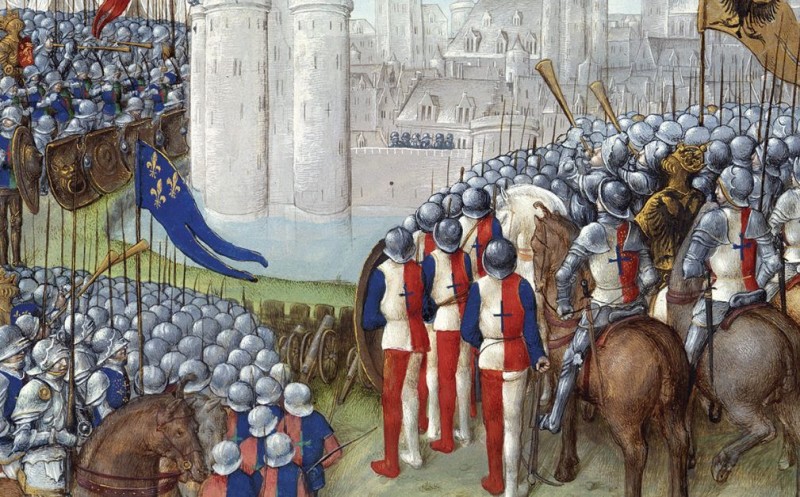
The Crusades were a series of religious and military campaigns that took place between the 11th and 13th centuries, with the primary aim of reclaiming control of the Holy Land from Muslim rulers. Spanning over two centuries, these expeditions left an indelible mark on history and continue to shape perceptions and relations between different communities in the modern world.
The First Crusade (1096-1099):
The First Crusade was called by Pope Urban II in 1095 in response to pleas from Byzantine Emperor Alexios I for aid against Muslim incursions into his territories. This campaign saw waves of enthusiastic volunteers, both knights and commoners, from Western Europe embarking on a journey to recapture Jerusalem.
After a grueling journey marked by hardship and losses, the Crusaders succeeded in capturing Jerusalem in 1099. Their victory resulted in the establishment of Christian states in the region, including the Kingdom of Jerusalem, the Principality of Antioch, the County of Edessa, and the County of Tripoli.
The Second Crusade (1147-1149):
The Second Crusade was triggered by the fall of Edessa to the Muslim ruler Zengi. European rulers, including King Louis VII of France and Emperor Conrad III of Germany, responded to the call for a new Crusade. However, their efforts were hindered by poor leadership, internal conflicts, and military setbacks.
The Crusaders suffered a devastating defeat at the hands of the Muslims, and the Second Crusade failed to achieve significant territorial gains. This setback led to disillusionment and weakened the Christian presence in the Holy Land.
The Third Crusade (1189-1192):
The Third Crusade is perhaps the most famous and significant of the Crusades. It was launched to recapture Jerusalem after its fall to Muslim leader Saladin in 1187. The crusade was led by three European monarchs: King Richard the Lionheart of England, King Philip II of France, and Emperor Frederick I of the Holy Roman Empire.
Although the Crusaders secured some concessions from Saladin, including the right for Christian pilgrims to visit Jerusalem, they could not fully recapture the city. Instead, they focused on safeguarding other Christian-held territories in the region.
The Fourth Crusade (1202-1204):
The Fourth Crusade is characterized by intrigue and betrayal. Initially intended to reach the Holy Land, the Crusaders faced financial difficulties and were diverted to attack the Christian city of Constantinople in 1204.
The sacking of Constantinople weakened the Byzantine Empire, and a new Latin Empire was established. The Fourth Crusade deeply strained relations between the Eastern and Western Christian churches.
The Children's Crusade (1212):
The Children's Crusade, often regarded as a tragic and ill-fated event, involved the participation of young, inexperienced individuals who believed that their innocence and purity would lead to divine intervention. Thousands of children embarked on a journey to the Holy Land, but most of them either perished or were captured and sold into slavery.
The Fifth Crusade (1217-1221):
The Fifth Crusade aimed to capture Egypt, a strategic center of power in the Muslim world. Led by King Andrew II of Hungary and Duke Leopold VI of Austria, the Crusaders launched an attack on the Egyptian city of Damietta. Although they initially achieved some success, their campaign ultimately failed to capture Cairo, the ultimate objective.
The Sixth Crusade (1228-1229):
The Sixth Crusade, led by Emperor Frederick II of the Holy Roman Empire, took a unique diplomatic approach. Instead of a full-fledged military campaign, Frederick negotiated a treaty with the Muslim leader Al-Kamil, securing the return of Jerusalem to Christian rule without bloodshed.
The Seventh and Eighth Crusades (1248-1272):
The Seventh and Eighth Crusades were led by King Louis IX of France. The Seventh Crusade aimed to capture Egypt, while the Eighth Crusade focused on the Holy Land. Although Louis IX's campaigns were marked by initial victories, they ultimately ended in defeat, and the Crusaders were unable to achieve their objectives.
Modern Implications and Lingering Animosity:
The Crusades left deep scars on the collective memory of both Christian and Muslim communities. While some see the Crusades as a noble defense of Christendom, others view them as a symbol of Western aggression and imperialism. These historical grievances continue to influence contemporary politics and interfaith relations, contributing to animosity and mistrust between different communities.
The Crusades were a series of complex and multi-faceted military campaigns that shaped the course of history and continue to resonate in modern times. Understanding the nuanced historical context and consequences of the Crusades is vital for fostering empathy, dialogue, and peaceful coexistence between diverse communities. By acknowledging the legacy of the Crusades and working towards reconciliation, we can strive for a more inclusive and tolerant world, where cultural and religious differences are embraced and celebrated.
Muharram 2023: Jammu govt postpones ‘Ashura’ holiday; See new date
Sindhi Religion: A Journey of Cultural and Spiritual Traditions
If you are going on the Kailash Mansarovar Yatra, do not forget to visit these places as well